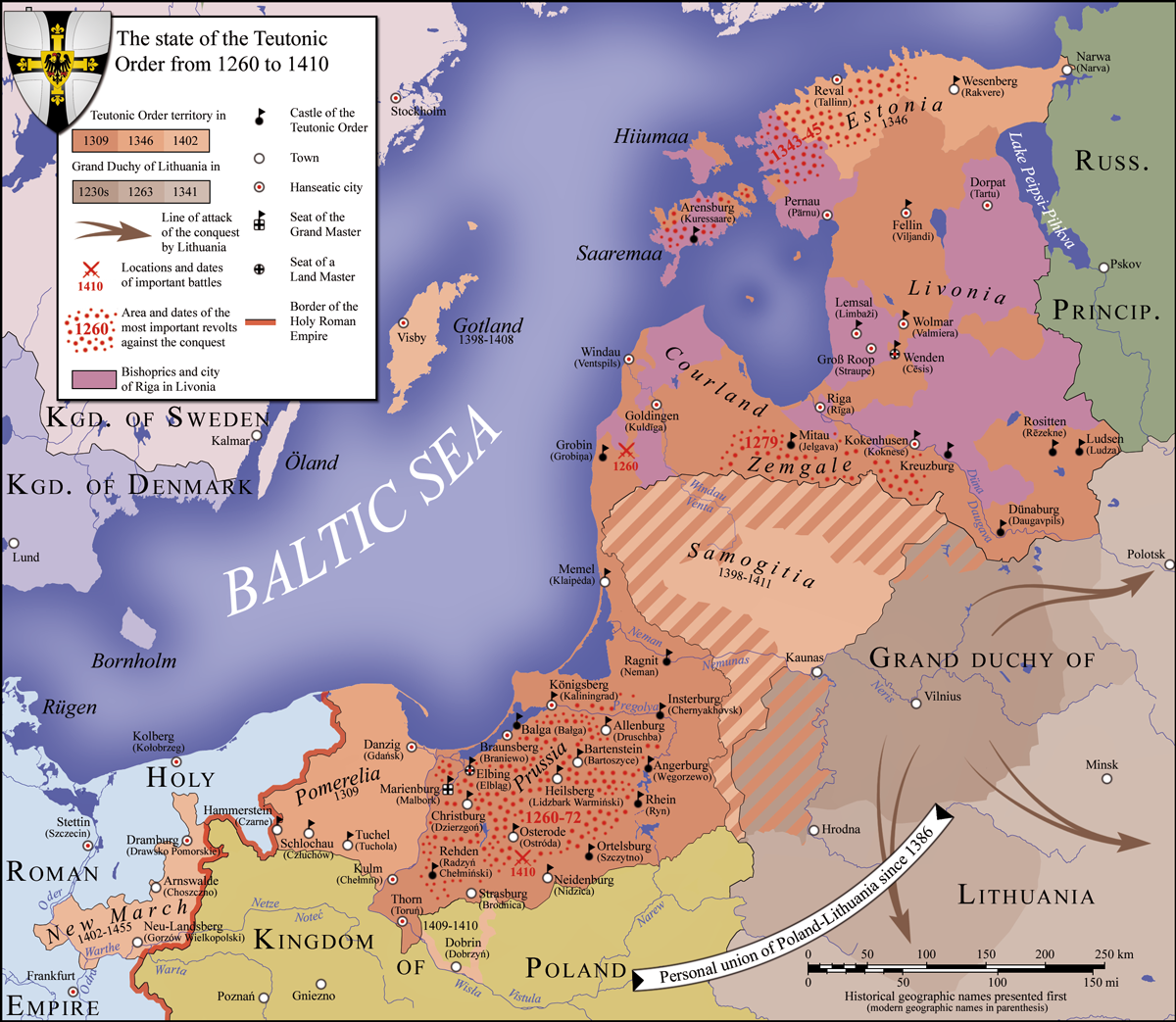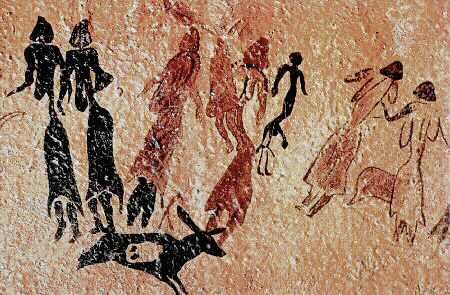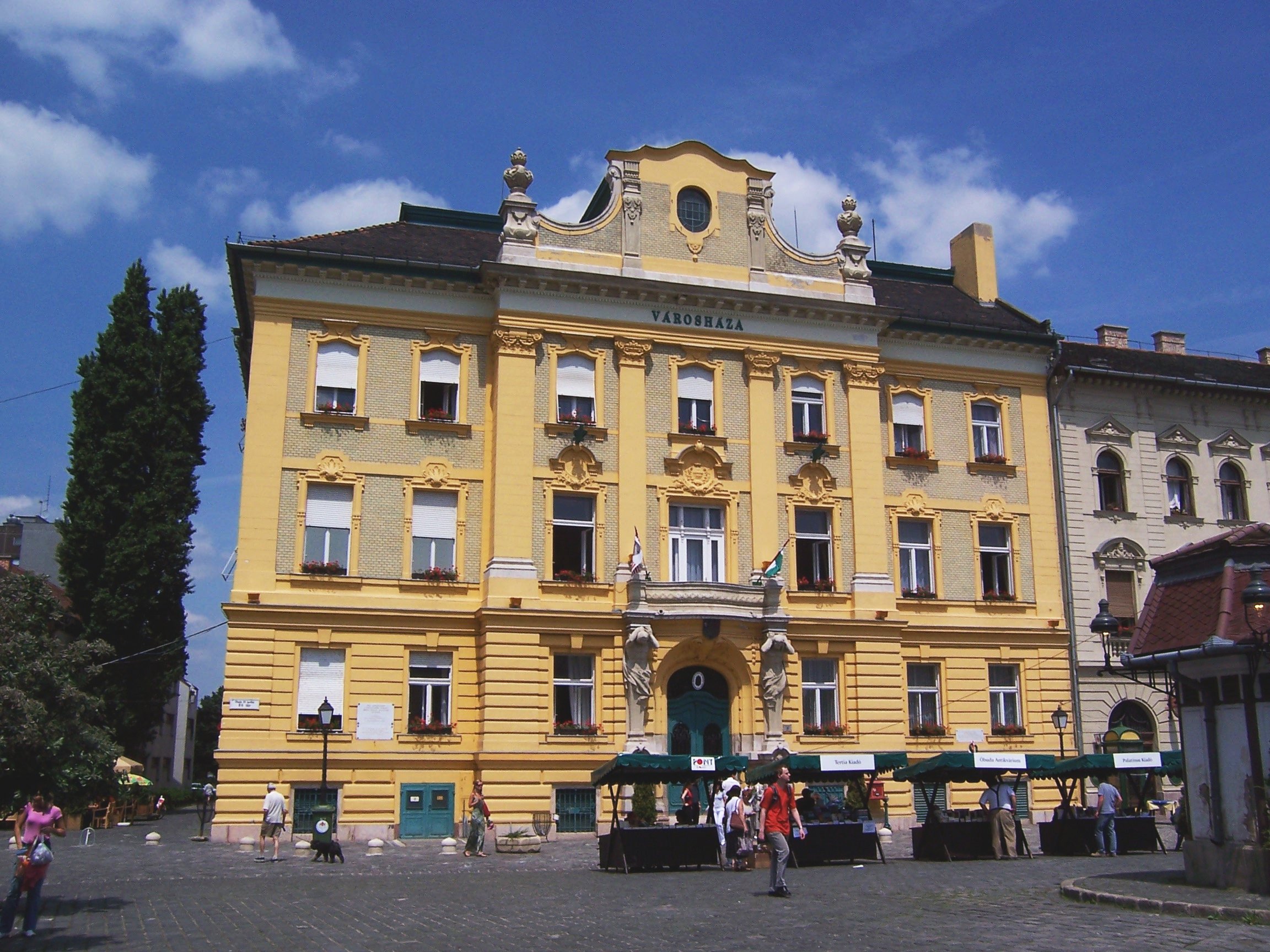|
Benedict Makrai
Benedict Makrai ( la, Benedictus de Macra, hu, Makrai Benedek, pl, Benedykt Makrai; 1360s – after 1421) was a well-educated Hungarian noble and diplomat in the service of Sigismund of Luxemburg, King of Hungary and later Holy Roman Emperor. He is best known for his 1412–13 mission to Poland– Lithuania to mediate their territorial dispute with the Teutonic Knights over Samogitia and Masovia in the aftermath of the Battle of Grunwald (1410). His mission did not resolve the dispute and only heightened the tensions. Early life and education Makrai was probably born in the second half of the 1360s. His birthplace is not known, but speculated to be in the Szatmár County now split between north-western Romania and north-eastern Hungary. He came from the Gacsalkér branch of the Szentemágócs kindred as the son of Blaise. His brothers were Sebastian, who served as ''ispán'' of the chamber of salt ( hu, sókamaraispán, mentioned in this capacity in 1397 and 1403), and Stephen, ... [...More Info...] [...Related Items...] OR: [Wikipedia] [Google] [Baidu] |
Szatmár County
Szatmár County ( hu, Szatmár vármegye ) was an administrative county (comitatus) of the Kingdom of Hungary, situated south of the river Tisza. Most of its territory is now divided between Romania and Hungary, while a very small area is part of Ukraine. The capital of the county was Nagykároly (now Carei). Geography After 1876, Szatmár county shared borders with the former Hungarian counties of Szabolcs, Bereg, Ugocsa, Máramaros, Szolnok-Doboka, Szilágy and Bihar. It was situated south of the river Tisza. The rivers Crasna, Someş, Lăpuș and Tur flowed through the county. Its area was 6,257 km2 around 1910. History Szatmár county was formed in the 11th century, with the center in Szatmárnémeti (now Satu Mare). In Ottoman times, the county mostly belonged to Partium. In 1876, when the administrative structure of the Kingdom of Hungary was changed, part of the territory of the former Kővárvidék/ Chioar district was annexed to Szatmár. In 1920, the T ... [...More Info...] [...Related Items...] OR: [Wikipedia] [Google] [Baidu] |
Quadrivium
From the time of Plato through the Middle Ages, the ''quadrivium'' (plural: quadrivia) was a grouping of four subjects or arts—arithmetic, geometry, music, and astronomy—that formed a second curricular stage following preparatory work in the '' trivium'', consisting of grammar, logic, and rhetoric. Together, the '' trivium'' and the ''quadrivium'' comprised the seven liberal arts, and formed the basis of a liberal arts education in Western society until gradually displaced as a curricular structure by the ''studia humanitas'' and its later offshoots, beginning with Petrarch in the 14th century. The seven classical arts were considered "thinking skills" and were distinguished from practical arts, such as medicine and architecture. The ''quadrivium'', Latin for 'four ways', and its use for the four subjects have been attributed to Boethius—who likely coined the term. It was considered the foundation for the study of philosophy (sometimes called the "liberal art ''par excel ... [...More Info...] [...Related Items...] OR: [Wikipedia] [Google] [Baidu] |
Ragnit
Neman (russian: Не́ман; german: Ragnit; lt, Ragainė; pl, Ragneta), is a town and the administrative center of Nemansky District in Kaliningrad Oblast, Russia, located in the historic region of Lithuania Minor, on the steep southern bank of the Neman River, where it forms the Russian border with the Klaipėda Region in Lithuania, and northeast of Kaliningrad, the administrative center of the oblast. Population figures: History ''Ragnita'' (from Old Prussian: ''ragas'', "spur"), founded in 1288, was a settlement of the Baltic (Old Prussian) tribe of Skalvians. It was contested by the Grand Duchy of Lithuania since its creation in the 13th century, and on April 23, 1289 it was conquered by the Teutonic Knights, who built a castle there between 1397 and 1409, which later became the seat of a ''Komtur''. Construction works were supervised by the Master of the Teutonic Order Konrad Fellenstein of Marienburg. A few decades later, a now-destroyed 25 meter guard tower w ... [...More Info...] [...Related Items...] OR: [Wikipedia] [Google] [Baidu] |
Malbork
Malbork; ; * la, Mariaeburgum, ''Mariae castrum'', ''Marianopolis'', ''Civitas Beatae Virginis'' * Kashubian: ''Malbórg'' * Old Prussian: ''Algemin'' is a town in the Pomeranian Voivodeship, Poland. It is the seat of Malbork County and has a population of 37,898 people as of 2021. The town is located on the Nogat river, in the historical region of Pomerelia. Founded in the 13th century by the Knights of the Teutonic Order, the town is noted for its medieval Malbork Castle, built in the 13th Century as the Order's headquarters, which was also one of the residences of Polish kings and seat of notable early modern Polish institutions. History of the castle The town was built in Prussia around the fortress Ordensburg Marienburg, which was founded in 1274 on the east bank of the river Nogat by the Teutonic Knights. Both the castle and the town (named Marienburg in German and Malborg or Malbork in Polish) were named for their patron saint, the Virgin Mary. This fortified castle ... [...More Info...] [...Related Items...] OR: [Wikipedia] [Google] [Baidu] |
Teutonic Order
The Order of Brothers of the German House of Saint Mary in Jerusalem, commonly known as the Teutonic Order, is a Catholic religious institution founded as a military society in Acre, Kingdom of Jerusalem. It was formed to aid Christians on their pilgrimages to the Holy Land and to establish hospitals. Its members have commonly been known as the Teutonic Knights, having a small voluntary and mercenary military membership, serving as a crusading military order for the protection of Christians in the Holy Land and the Baltics during the Middle Ages. Purely religious since 1810, the Teutonic Order still confers limited honorary knighthoods. The Bailiwick of Utrecht of the Teutonic Order, a Protestant chivalric order, is descended from the same medieval military order and also continues to award knighthoods and perform charitable work. Name The name of the Order of Brothers of the German House of Saint Mary in Jerusalem is in german: Orden der Brüder vom Deutschen Haus de ... [...More Info...] [...Related Items...] OR: [Wikipedia] [Google] [Baidu] |
Teutonic Order 1410
Teutonic or Teuton(s) may refer to: Peoples and cultures * Teutons, a Germanic tribe or Celtic tribe mentioned by Greek and Roman authors ** ''Furor Teutonicus'', a Latin phrase referring to the proverbial ferocity of the Teutons * Having qualities related to classical Germanic peoples ''(dated)'' * Pertaining to Germanic languages or speakers of those languages ''(dated)'' ; see Theodiscus * Having qualities related to modern Germans or Austrians ''(poetic)'' * Nordic race, a putative sub-race discussed in the 19th to mid-20th centuries Other uses * A German Catholic order, the Teutonic Order **State of the Teutonic Order, the Northern European country it once formed * Teutonic, West Virginia Teutonic was an unincorporated community in Marshall County, West Virginia West Virginia is a state in the Appalachian, Mid-Atlantic and Southeastern regions of the United States.The Census Bureau and the Association of American Geogr ... * RMS ''Teutonic'', a steam shi ... [...More Info...] [...Related Items...] OR: [Wikipedia] [Google] [Baidu] |
Catalonia
Catalonia (; ca, Catalunya ; Aranese Occitan: ''Catalonha'' ; es, Cataluña ) is an autonomous community of Spain, designated as a '' nationality'' by its Statute of Autonomy. Most of the territory (except the Val d'Aran) lies on the northeast of the Iberian Peninsula, to the south of the Pyrenees mountain range. Catalonia is administratively divided into four provinces: Barcelona, Girona, Lleida, and Tarragona. The capital and largest city, Barcelona is the second-most populated municipality in Spain and the fifth-most populous urban area in the European Union. > > > ''Catalonia'' theoretically derived. During the Middle Ages, Byzantine chroniclers claimed that ''Catalania'' derives from the local medley of Goths with Alans, initially constituting a ''Goth-Alania''. Other theories suggest: *''Catalunya'' derives from the term "land of castles", having evolved from the term ''castlà'' or ''castlan'', the medieval term for a castellan (a ruler of a castl ... [...More Info...] [...Related Items...] OR: [Wikipedia] [Google] [Baidu] |
Pápoc
Pápoc is a village in Vas county, Hungary Hungary ( hu, Magyarország ) is a landlocked country in Central Europe. Spanning of the Carpathian Basin, it is bordered by Slovakia to the north, Ukraine to the northeast, Romania to the east and southeast, Serbia to the south, Croa .... Sightseeing for visitors: the old rotunda of Árpád age In the village there is an old architectural heritage from the romanesque art: the old rotunda. It was built in the 13th century. The inner space consists of four apses surrounding a central circular space. The rotunda has two floors: the stairs go up in a corridor inside the wall. The rotunda is built together with a monastery of St. Agustino Order. It has beautiful southern doorway. Outer references * Gervers-Molnár, V. (1972): A középkori Magyarország rotundái. (Rotunda in the Medieval Hungary). Akadémiai, Budapest * Gerevich Tibor: Magyarország románkori emlékei. (Die romanische Denkmäler Ungarns.) Egyetemi nyomda. Bu ... [...More Info...] [...Related Items...] OR: [Wikipedia] [Google] [Baidu] |
Ladislaus Of Naples
Ladislaus the Magnanimous ( it, Ladislao, hu, László; 15 February 1377 – 6 August 1414) was King of Naples from 1386 until his death and an unsuccessful claimant to the kingdoms of Hungary and Croatia. Ladislaus was a skilled political and military leader, protector and controller of Pope Innocent VII; however, he earned a bad reputation concerning his personal life. He profited from disorder throughout Italy to greatly expand his kingdom and his power, appropriating much of the Papal States to his own use. He was the last male of the Capetian House of Anjou. Youth Ladislaus was born in Naples on 15 February 1377 during the reign of his grandaunt Queen Joanna I of Naples. He was the son of Charles and Margaret of Durazzo, both members of the Capetian House of Anjou. His parents, having lived for years at the court of their kinsman King Louis I of Hungary, named him after King Saint Ladislaus I of Hungary. In 1379 his father declared war on Joanna and proclaimed himself kin ... [...More Info...] [...Related Items...] OR: [Wikipedia] [Google] [Baidu] |
Kingdom Of Hungary
The Kingdom of Hungary was a monarchy in Central Europe that existed for nearly a millennium, from the Middle Ages into the 20th century. The Principality of Hungary emerged as a Christian kingdom upon the coronation of the first king Stephen I at Esztergom around the year 1000;Kristó Gyula – Barta János – Gergely Jenő: Magyarország története előidőktől 2000-ig (History of Hungary from the prehistory to 2000), Pannonica Kiadó, Budapest, 2002, , p. 687, pp. 37, pp. 113 ("Magyarország a 12. század második felére jelentős európai tényezővé, középhatalommá vált."/"By the 12th century Hungary became an important European factor, became a middle power.", "A Nyugat részévé vált Magyarország.../Hungary became part of the West"), pp. 616–644 his family (the Árpád dynasty) led the monarchy for 300 years. By the 12th century, the kingdom became a European middle power within the Western world. Due to the Ottoman occupation of the central and s ... [...More Info...] [...Related Items...] OR: [Wikipedia] [Google] [Baidu] |
Óbuda
Óbuda was a town in Hungary that was merged with Buda and Pest on 17 November 1873; it now forms part of District III-Óbuda-Békásmegyer of Budapest. The name means ''Old Buda'' in Hungarian (in German, ''Alt-Ofen''). The name in Bosnian, Croatian and Serbian for this city is ''Stari Budim'', but the local Croat minority calls it ''Obuda'' (the name "Budim" is used for the fortress in Buda). In Czech it is called ''Starý Budín''. The island ( Óbuda Island) next to this part of the city today hosts the Sziget Festival, a huge music and cultural festival. Óbuda's centre is ''Fő tér'' (Main Square), connected to a small square with a sculpture of people waiting for the rain to stop. It is accessible by HÉV (''Szentlélek tér'' station). History Settlements dating from the Stone Age have been found in Óbuda. The Romans built there Aquincum, the capital of Pannonia province. Hungarians arrived after 900 and it served as an important settlement of major tribal lead ... [...More Info...] [...Related Items...] OR: [Wikipedia] [Google] [Baidu] |
University Of Padua
The University of Padua ( it, Università degli Studi di Padova, UNIPD) is an Italian university located in the city of Padua, region of Veneto, northern Italy. The University of Padua was founded in 1222 by a group of students and teachers from Bologna. Padua is the second-oldest university in Italy and the world's fifth-oldest surviving university. In 2010, the university had approximately 65,000 students. In 2021, it was ranked second "best university" among Italian institutions of higher education with more than 40,000 students according to Censis institute, and among the best 200 universities in the world according to ARWU. History The university is conventionally said to have been founded in 1222 when a large group of students and professors left the University of Bologna in search of more academic freedom ('Libertas scholastica'). The first subjects to be taught were law and theology. The curriculum expanded rapidly, and by 1399 the institution had divided in two: a ''U ... [...More Info...] [...Related Items...] OR: [Wikipedia] [Google] [Baidu] |




